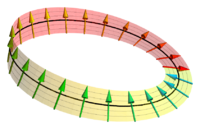
Photo from wikipedia
Following the discovery of topological insulators (TIs), topological Dirac/Weyl semimetal has attracted much recent interest. A prevailing mechanism for the formation of Weyl points is by breaking time-reversal symmetry (TRS)… Click to show full abstract
Following the discovery of topological insulators (TIs), topological Dirac/Weyl semimetal has attracted much recent interest. A prevailing mechanism for the formation of Weyl points is by breaking time-reversal symmetry (TRS) or spatial inversion symmetry of a Dirac point. Here we demonstrate a generic formation mechanism for Weyl points by breaking TRS of a three-dimensional (3D) TI featured with highly degenerate 3D flat bands (FBs). It is in direct contrast to the conventional view that breaking TRS of a 2D/3D TI leads to a Chern insulator exhibiting quantum anomalous Hall effect. Based on a tight-binding model of pyrochlore lattice, we show that this unusual 3D-FB-enabled Weyl state may contain only a minimum of two Weyl points. Furthermore, using first-principles calculations, we identify this Weyl state in a real material Sn$_2$Nb$_2$O$_7$. The main features of the resulting Weyl points are analyzed with respect to symmetry, topological invariant and surface state. Our finding sheds new light on our fundamental understanding of topological physics and significantly extends the scope of Weyl semimetals to attract immediate experimental interest.
Journal Title: Physical Review B
Year Published: 2019
Link to full text (if available)
Share on Social Media: Sign Up to like & get
recommendations!